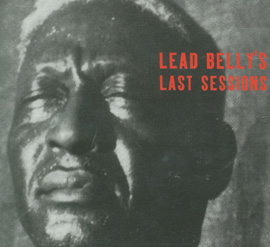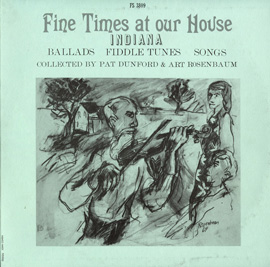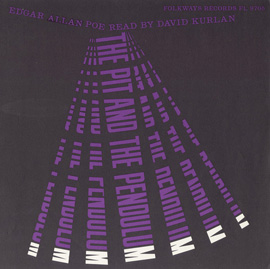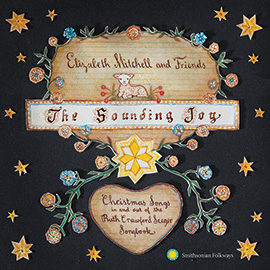-
Folkways Fast Five: Mary Monseur
Fast Five is a five-question speed interview with members of the Smithsonian Folkways Recordings staff.
Hello, and welcome to Fast Five, where we at Smithsonian Folkways Recordings talk to a member of the staff about their favorite parts of the collection. I’m Hannah Judd, and I’m here today with Mary Monseur. Could you introduce yourself?
Yes, I’m Mary Monseur, and I’ve been with Smithsonian Folkways for about twenty-one years now. My job is production manager, so I work on all the new recordings that come onto the schedule and eventually come out on the label.
What was your first Folkways album?
 My first Folkways album was Lead Belly’s Last Sessions. It was at the very beginning, when I first started working here, and I was given the liner notes to proofread. I had never heard of Lead Belly before. So I was reading his story before I actually heard his music. I was very fascinated by his story, and then I heard his music, and I was completely blown away by his voice, by his singing, and his guitar playing, I became an instant fan of Lead Belly. And then afterwards I read a book about him, I wanted to learn more and more about him. So that was my first real introduction to Folkways.
My first Folkways album was Lead Belly’s Last Sessions. It was at the very beginning, when I first started working here, and I was given the liner notes to proofread. I had never heard of Lead Belly before. So I was reading his story before I actually heard his music. I was very fascinated by his story, and then I heard his music, and I was completely blown away by his voice, by his singing, and his guitar playing, I became an instant fan of Lead Belly. And then afterwards I read a book about him, I wanted to learn more and more about him. So that was my first real introduction to Folkways.
What are some of your current favorite albums? What do you like about them?
 I would say my most enduring favorite album is Lucinda Williams’ Happy Woman Blues. I’m a really big fan of hers and I love her songwriting. I love her voice, but I also love the way that she weaves Southern culture into her songs and in her material, but also in her style. I’ve been listening to her for ages.
I would say my most enduring favorite album is Lucinda Williams’ Happy Woman Blues. I’m a really big fan of hers and I love her songwriting. I love her voice, but I also love the way that she weaves Southern culture into her songs and in her material, but also in her style. I’ve been listening to her for ages.
My other favorite albums, I really love the Woody Guthrie, [Songs to Grow On For Mother And Child]. I’ve recently listened to that a lot; I was working on that album. I listened to it very closely, and I realized that his songs, especially the kids songs, are so filled with love, but they’re also very clever. They’re simple but very clever and enduring. So I really like that album, and I think I like all his kids material.
I also am a big fan of Elizabeth Mitchell’s albums. The first one she released on Folkways is called [You Are My Little Bird], and that’s a lovely album. When I listen to it I feel like I’m in a room with natural light, it’s beautiful. Her most recent album, The Sounding Joy, takes a lot of old Christmas songs, before Christmas was commercialized. She took a lot of the songs from the Ruth Crawford Seeger songbook and re-arranged them and did a lovely, masterpiece recording. I’m very fond of it.
 Another one I really like—kind of a different genre is Los Pleneros de la 21 [Para Todos Ustedes]. I love that music. It’s great dance music; it’s a beautifully recorded album. Sonically it’s awesome.
Another one I really like—kind of a different genre is Los Pleneros de la 21 [Para Todos Ustedes]. I love that music. It’s great dance music; it’s a beautifully recorded album. Sonically it’s awesome.
What’s a hidden gem in the collection?
 In the back catalog, there’s a recording called Fine Times At Our House, and it was recorded in the early 1960s, in Indiana, which is kind of interesting. You don’t hear about that much folk music coming from the Midwest. The album itself, is really interesting to me, the songs are interesting, but it’s also the sound of it and the diversity of material that’s on the album—the different kinds of songs and the people singing them. In some ways, it kind of reminds me of what you would read in the Harry Smith Anthology [of American Folk Music]about the weird old America. It is the old America that’s probably now gone. Maybe this type of music is gone, but when you listen to it, it’s almost like going [far] back in time, even though it wasn’t really that long ago. I’m very fascinated by it, and I’d like to hear the rest of the music that those folklorists recorded. Apparently they recorded a lot, but there’s just this one album.
In the back catalog, there’s a recording called Fine Times At Our House, and it was recorded in the early 1960s, in Indiana, which is kind of interesting. You don’t hear about that much folk music coming from the Midwest. The album itself, is really interesting to me, the songs are interesting, but it’s also the sound of it and the diversity of material that’s on the album—the different kinds of songs and the people singing them. In some ways, it kind of reminds me of what you would read in the Harry Smith Anthology [of American Folk Music]about the weird old America. It is the old America that’s probably now gone. Maybe this type of music is gone, but when you listen to it, it’s almost like going [far] back in time, even though it wasn’t really that long ago. I’m very fascinated by it, and I’d like to hear the rest of the music that those folklorists recorded. Apparently they recorded a lot, but there’s just this one album.
What’s your favorite album art?
 I have two favorites. So The Pit and Pendulum, which is from the back catalog—that’s my favorite graphic kind of artwork. The reason I love it is because of the simplicity. Back in those days when they were creating this, they actually had to mock this up [by hand]. They created artwork by mocking it up on a board, and then they would have to take a picture of it, and that’s what would go to the printer to be made into film. I’ve seen this actual piece of work in the job bags [in the archives]. The way they did it—this was all done by hand, all these letters were cut out by hand and pasted on. The attention to detail and also the use of colors—the black and then the purple and then the white at the bottom that really causes that movement, it’s just, it’s brilliant. I love it! It works really well for that story and for what you hear when you listen to this record.
I have two favorites. So The Pit and Pendulum, which is from the back catalog—that’s my favorite graphic kind of artwork. The reason I love it is because of the simplicity. Back in those days when they were creating this, they actually had to mock this up [by hand]. They created artwork by mocking it up on a board, and then they would have to take a picture of it, and that’s what would go to the printer to be made into film. I’ve seen this actual piece of work in the job bags [in the archives]. The way they did it—this was all done by hand, all these letters were cut out by hand and pasted on. The attention to detail and also the use of colors—the black and then the purple and then the white at the bottom that really causes that movement, it’s just, it’s brilliant. I love it! It works really well for that story and for what you hear when you listen to this record.
 My other favorite, the Sonny Terry On the Road cover. It’s not the design of it I like so much but that photo. When you look at this in the real size of the album cover and you see what’s going on in this photo; in his glasses, there’s a whole world in there. It’s the coolest photograph, it’s one of those photographs where you’re like, “wow, I don’t know how the photographer caught this.” It’s just beautiful, it’s beautifully done. It’s also shot by one of my favorite photographers, David Gahr. I didn’t know about him until I came to Folkways. I had seen his photography, but I never knew it was him. I discovered who he really was when I was at Folkways and I started working on productions. I would go into the archives and see the old job bags and the old files and things. I would pull out stunning photographs, and every time I’d love one of them I’d turn it over and it would say “Photo by David Gahr.” Eventually, I talked to him on the phone and I started working with him, and I even went to visit him several times and sat in his kitchen. He lived in an old brownstone up in Brooklyn, like five stories, and he had thousands and thousands of photographs in boxes. When I would be doing research, he’d come with boxes, some of them hadn’t been opened in thirty years. He would open these and the photos would be stunningly beautiful. He was a real crotchety, old kind of guy, a real character, an unbelievable character, but an amazing artist, an amazing person. So it’s funny, I fell in love with this photo before I knew who he [David Gahr] was, but then knowing it was his and then getting to know him, I love it now more because of that.
My other favorite, the Sonny Terry On the Road cover. It’s not the design of it I like so much but that photo. When you look at this in the real size of the album cover and you see what’s going on in this photo; in his glasses, there’s a whole world in there. It’s the coolest photograph, it’s one of those photographs where you’re like, “wow, I don’t know how the photographer caught this.” It’s just beautiful, it’s beautifully done. It’s also shot by one of my favorite photographers, David Gahr. I didn’t know about him until I came to Folkways. I had seen his photography, but I never knew it was him. I discovered who he really was when I was at Folkways and I started working on productions. I would go into the archives and see the old job bags and the old files and things. I would pull out stunning photographs, and every time I’d love one of them I’d turn it over and it would say “Photo by David Gahr.” Eventually, I talked to him on the phone and I started working with him, and I even went to visit him several times and sat in his kitchen. He lived in an old brownstone up in Brooklyn, like five stories, and he had thousands and thousands of photographs in boxes. When I would be doing research, he’d come with boxes, some of them hadn’t been opened in thirty years. He would open these and the photos would be stunningly beautiful. He was a real crotchety, old kind of guy, a real character, an unbelievable character, but an amazing artist, an amazing person. So it’s funny, I fell in love with this photo before I knew who he [David Gahr] was, but then knowing it was his and then getting to know him, I love it now more because of that.Thank you!
You’re welcome.
Folkways Fast Five: Mary Monseur | Smithsonian Folkways Recordings




